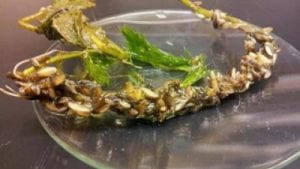 Zebra mussels are very prolific breeders, with adult females producing anywhere from 30,000 to 1.6 million eggs per year. The zebra mussel is a filter feeder, with each adult capable of clearing the algae from a quart of water each day. A thousand zebra mussels can thus filter 250 gallons of water each day. As the mussels filter algae out of the water, the water typically becomes considerably clearer. Increased water clarity exposes more of the lake’s bottom to sunlight, resulting in more habitats for aquatic plants. But, the increase in vegetation may be troubling to some lake users, as plants can interfere with boat propellers and swimming areas.
Zebra mussels are very prolific breeders, with adult females producing anywhere from 30,000 to 1.6 million eggs per year. The zebra mussel is a filter feeder, with each adult capable of clearing the algae from a quart of water each day. A thousand zebra mussels can thus filter 250 gallons of water each day. As the mussels filter algae out of the water, the water typically becomes considerably clearer. Increased water clarity exposes more of the lake’s bottom to sunlight, resulting in more habitats for aquatic plants. But, the increase in vegetation may be troubling to some lake users, as plants can interfere with boat propellers and swimming areas.
Zebra mussels were first reported in Geist Reservoir in April 2010 by the DNR (Department of Natural Resources). Presence in Geist should worry residents and the water company. According to the USGS, every year millions of dollars are spent just to clean drainage and filtration pipes clogged by the mussels. Besides pipes, mussels can attach to anything, including rocks, boats, fish, crayfish, water snails and plants. To assess the extent of the infestation, staff scientist and a team of undergraduates at CEES conducted a brief study in August 2012 and collected a few stems of Eurasian water milfoil (Myriophyllum spicatum) within 1 square foot at a random location in the reservoir. Stems and leaves of the aquatic plants were covered by several hundreds of mussels. Estimated densities are 800 ind/sq. ft or 7,200 individuals per square meter. According to the literature, population densities range from 7,000 to 115,000 ind/m2. This only means that we are seeing the beginning of the infestation and the worse is to come! Geist waters may become clearer in the next coming years but at what cost?